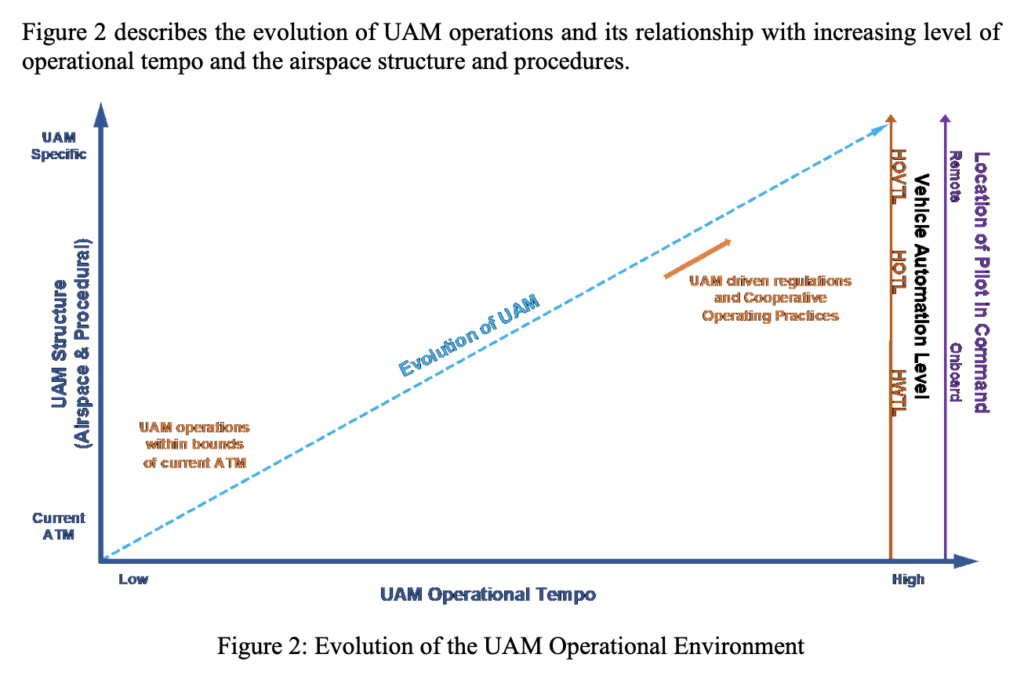FAA Updates Its Blueprint for Future Air Taxi Operations


The FAA has taken steps to plan for a smooth integration of advanced air mobility operations through the release of its Urban Air Mobility Concept of Operations 2.0 blueprint. (Photo: FAA)
The introduction and integration of advanced air mobility (AAM) operations, which includes electric air taxis and autonomous vehicles, is one of the challenges currently facing the aviation industry. With a variety of developers inching closer to feasible prototypes and a multitude of operators demonstrating interest in beginning commercial service with AAM aircraft, the Federal Aviation Administration has taken steps to plan for a smooth integration of this technology into pre-existing infrastructure through the release of its Urban Air Mobility Concept of Operations 2.0 blueprint.
The release of this document comes at a time of promise for air taxis and other eVTOL (electric vertical take-off and landing) operations. Developers across the world are finalizing prototypes of small aircraft designed for short, urban flights. Perhaps most notably, Archer’s Midnight aircraft has already received orders from United Airlines. The carrier, which ordered 100 units, aims to place the aircraft in service as soon as next year. With ambitions like this from such a major airline, it seems planning to accommodate this technology is a critical step in maintaining the safety of air travel.
Delta Air Lines has also entered into a long-term partnership with eVTOL developer Joby Aviation to launch services. The airline made an upfront equity investment into Joby that totaled $60 million.
Acting as an updated regulatory blueprint, this document outlines changes in air space and procedure to accommodate eVTOL aircraft and similar AAM operations. This blueprint is not concrete legislation and has no permanence. Rather, as the document explains, “It is a target description of the evolution of integration from the near-term Innovate 28 environment to a future of high-density urban operations. The concept focuses on a potential longer-term target supporting exploration and validation efforts. Future versions of the ConOps will reflect the outcomes of analyses, trials, concept maturation, and collaboration.” Upon the entrance of eVTOL operations to commercial service, more adjustments will be made to better accommodate the technology and ensure safe and efficient operations.

The evolution of the operational environment for urban air mobility, or UAM (Photo: FAA)
As the first air taxis enter service, they’ll follow most general aviation regulations. This means eVTOL aircraft will utilize existing infrastructure, operating much like helicopters do currently. Launches and landings will be performed on helipads and vertiports in city centers, and flights will use existing routes while communicating with air traffic control when necessary. Additionally, for the foreseeable future, air taxis will only be permitted to operate on one-way paths.
As air taxis gain popularity, the segment will begin using its own infrastructure like new vertiports and corridors dedicated to connecting them. This could lead to the development of new regulation to accommodate technological advancements—namely, concepts like uncrewed flights and two-way operations. However, as the Urban Air Mobility Concept of Operations 2.0 demonstrates, for the time being the FAA is focused on slowly introducing air taxis to existing infrastructure before accommodating the technology with new regulations.
The post FAA Updates Its Blueprint for Future Air Taxi Operations appeared first on Avionics International.
—————
Boost Internet Speed–
Free Business Hosting–
Free Email Account–
Dropcatch–
Free Secure Email–
Secure Email–
Cheap VOIP Calls–
Free Hosting–
Boost Inflight Wifi–
Premium Domains–
Free Domains





